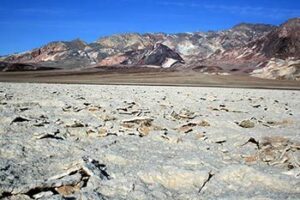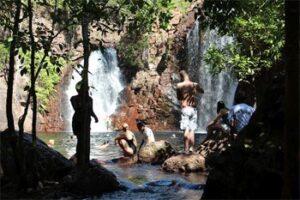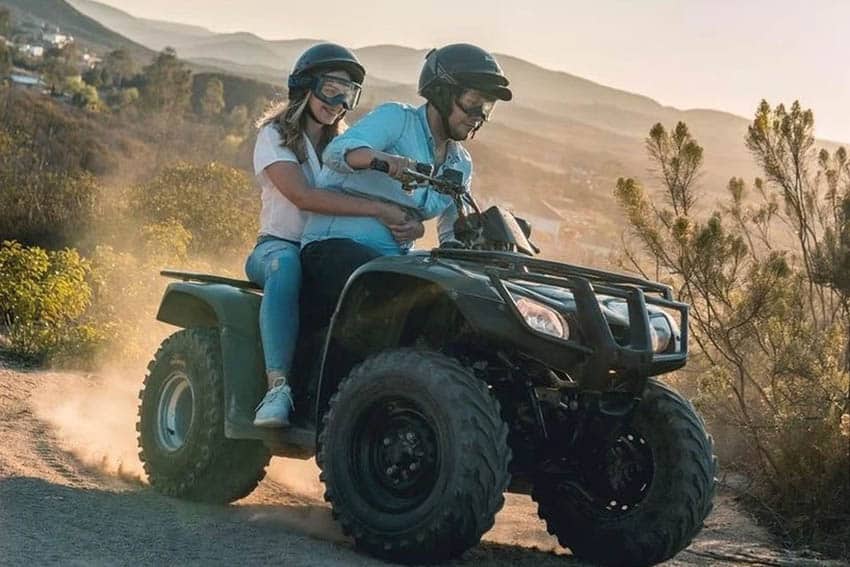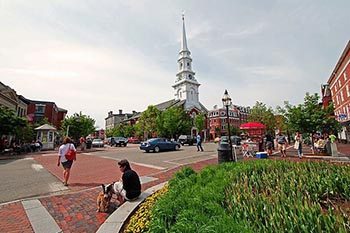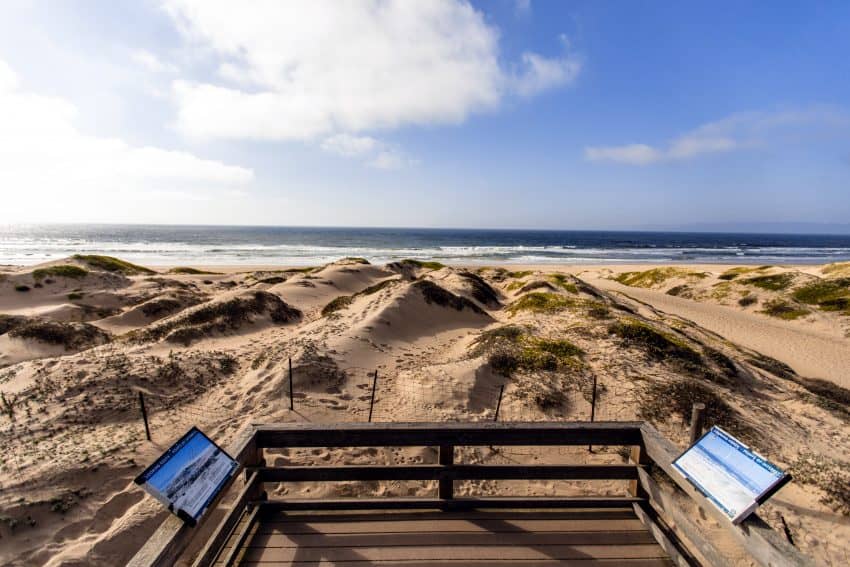
By Mary Charlebois
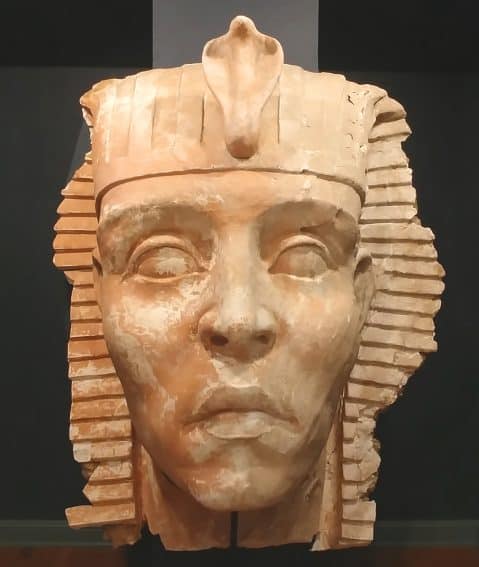
It’s hard to imagine that Guadalupe California was once the location for a Hollywood blockbuster. This sleepy little town in Santa Maria Valley, at the intersection of CA Hwy 1 and the Santa Maria River has a Hollywood connection that was buried for 60 years.
In 1923, Cecil B DeMille used hundreds of acres of dunes around Guadalupe California for a silent movie set. The blockbuster movie, Ten Commandments, staged the sand as Egypt.
DeMille’s set was the largest ever built. Some say it still holds the record. A small city of five-hundred tents was set up to house the thousands of set builders, extras, actors, costumes, photographers, and stagehands. 125-cooks were employed to feed the mob.
After weeks of filming, the work was complete. The tent city was dismantled, everyone left. DeMille had the massive set blown up and buried in the dunes. While no one knows precisely why it’s believed he did it so no other movie maker would use his creation.
The life-sized set was forgotten by most folks after the 1930s. Locals pilfered some pieces, but most remained buried. In 1983, Peter Brosnan began searching for the “Lost City of DeMille.” Others became involved, and an odd sort of archaeological dig began. (View the classic silent film HERE.)
Guadalupe-Nipomo Dunes Center
The digging continues today to recover DeMille’s set. In the Guadalupe-Nipomo Dunes Center, some of the salvaged pieces are displayed. The story of how the sphinxes came to be and how they were forgotten for 60-years, then recovered, is well presented.

The Dunes Center is the gateway to the coastal dunes. Make this your first stop to learn about the history, flora, and fauna.
At the center, you’ll find info for hiking the dunes and beaches. Ask about docent-led walks and guest speakers during your visit.
If you live in an area with sand, bring a small sample with you. Two tablespoons will do. The center is collecting sand samples from around the globe. website
Rancho Guadalupe Dunes Preserve
Just over the border in Santa Barbara County, Rancho Guadalupe Dunes Preserve protects 550-foot high sand dunes, the tallest on the west coast. You can walk the dunes, surf, fish, hike, go birding, watch wildlife, and take spectacular photos. website
Oso Flaco Lake Natural Area

It’s said to be one of the most beautiful and diverse natural areas on the California coast. Take pleasure in easy hiking through wooded areas, a lake, a boardwalk through the dunes, and finally the beach. The photo ops are exceptional, wildlife is abundant, and picnics are unforgettable. website
Oceano Dunes State Vehicle Recreation Area
This is the only California State Park allowing non-street legal vehicles to drive on the beach and dunes. ATV’s, motorcycles, and dune buggies may roam freely on the dunes and beach. Beach camping is available in the park, a rare treat. website
Butterfly Dunes
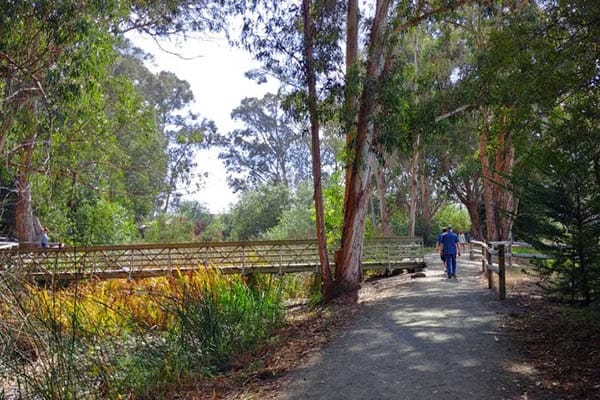
At the Monarch Butterfly Grove, from November through February, migrating Monarchs use the dunes and eucalyptus groves for R&R from their winter trip to Mexico. It is a natural spectacle that will delight everyone. website
The best way to experience butterflies is to sit or stand very still and very quiet among the trees in the grove. At peak migration, hundreds of thousands of black and orange Monarch butterflies fill the air, gliding, feeding and resting in the branches of eucalyptus and pine trees. The magic of the Monarchs can’t be overstated, don’t miss it.
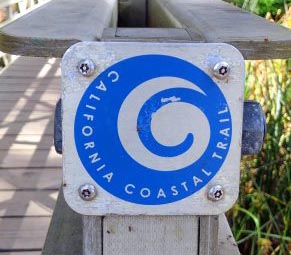
Even without butterflies, hiking here is easy-going and covers diverse landscapes. It includes woodlands, dunes, and beach. The hiking trails are part of the California Coastal Trail.
Luffa farm in the sand
The luffa is a gourd related to cucumbers. It’s a tropical vine bearing long cylindrical fruits most folks think of as bath or kitchen sponges. The sandy soil and sunshine at The Luffa Farm, make ideal growing conditions for the plant. Tours are free and very interesting. website
If you go
SLEEP—Santa Maria Inn, is a registered historic landmark, 10-miles from Guadalupe.
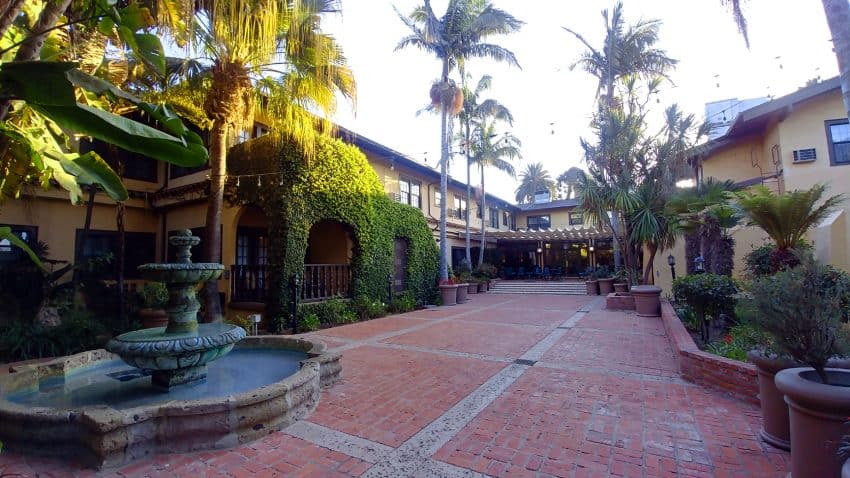
A secret Spanish courtyard in the middle of the hotel is stunning. Spanish tiles, tropical plants, and a fountain are transportive. This notable hotel opened in 1917 as a country inn serving guests decompressing from life in LA during the first half of the 20th-century.
The hotel has a modern tower and the original 1920s building. The original section of the hotel shares a history of Hollywood stars with Guadalupe. Many of the stars that worked on Ten Commandments stayed at Santa Maria Inn. Stroll around the large public areas. They are used as a gallery for photos and mementos of the golden age.
In the older section of the building, you can stay in the same room as Marilyn Monroe, John Wayne, Gary Cooper, and numerous other silver screen stars.

The hotel pool area is inviting for all ages and abilities. Restaurants and bars in the hotel serve BL&D and locally made libations. website
Santa Maria Valley BBQ
EAT— Santa Maria Valley is known for BBQ. In the 1800s, Santa Maria Valley was occupied by Old-California Spanish and Mexican ranchos. After taking the cattle to market, ranchers held celebrations for their vaqueros. Simply seasoned sides of beef were cooked on skewers over open pits filled with coals from the indigenous red oak tree. The Spanish-style celebrations always included pinquitos, pearl-sized pink beans grown in the valley.
Beginning in the 1930s, Santa Maria Style moved from ranchos to local restaurants and festivals. Today some of those original eateries are still serving a taste of early California heritage.
Down the street from Santa Maria Inn, try Shaw’s Steakhouse. Here you’ll experience the 150-year old Santa Maria Style barbecue tradition. Don’t expect to eat light here, the portions are ginormous and

scrumptious. If you’re staying at the Santa Maria Inn, I suggest walking. website
Getting there
AUTO—Take Main Street (Hwy 166) from Santa Maria to Guadalupe, about 9-miles
TRAIN— Amtrak has two famous train routes serving the area. From the north, the Coast Starlight runs from Seattle to Los Angeles and stops in San Luis Obispo. From there rent a car for the remaining 30-miles south to Guadalupe.
From the south, The Pacific Surfliner travels from San Diego to San Luis Obispo, with a stop at Guadalupe’s train station. You could also detrain in San Luis Obispo and rent a car for the remaining 30-miles south to Guadalupe.
AIR—San Luis Obispo County Regional Airport (SBP) has highly rated service from United, American, and Alaska Airlines. A modern, efficient terminal opened in 2017. Rent a car for the remaining 30-miles to Guadalupe.
For more information about travel in this area, visit Santa Maria Valley
*Photos: Charlebois and Santa Maria Valley
- Varna: A Pearl On The Black Sea Riviera - February 5, 2024
- Phoenicia Malta—A Host To World History - October 6, 2023
- Rollink Collapsible Luggage - October 21, 2022


